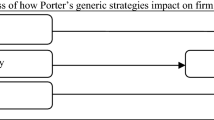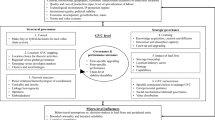Abstract
Abstract and Key Results
-
This paper’s objective is to articulate, more precisely than has occurred in the past, the principal theory rationales underlying the Multinationality/Performance (M/P) link, by examining each claim for the negative or positive benefits of internationalization, from the lens of the theory of the firm and the multinational enterprise. A concurrent objective of this paper is to respond to critiques of M/P theory and discuss methodology and operationalization problems in empirical testing.
-
While international expansion of a firm will not necessarily always improve performance (during the initial international expansion stage, or in cases where a firm may have over-internationalized), for the most part, over the considerable middle range of expansion, net positive benefits accrue from internationalization. Underlying theory rationales are detailed in the paper.
-
The results of over one hundred empirical studies over the past 30 years appear, on superficial examination, to be contradictory, but can be reconciled by the recently proposed 3-stage or S-shaped general theory.
Similar content being viewed by others
References
Bartlett, C./ Ghoshal, S., Managing Across Borders: The Transnational Solution, Boston: Harvard Business School Press 1989.
Buckley, P. J., The Limits of Explanation: Testing the Internalization Theory, Journal of International Business Studies, 19,2, 1988, pp. 181–194.
Buckley, P. J./ Casson, M. C., The Future of the Multinational Enterprise, London: Homes & Meier 1976.
Caves, R., International Corporations: Industrial Economics of Foreign Investment, Economica, 38,149, 1971, pp. 1–27.
Caves, R., Multinational Enterprise and Economic Analysis, Cambridge, MA: Cambridge University Press 1996.
Contractor, F.J., Valuation of Intangible Assets in Global Operations, Westport, CT: Quorum Books, Greenwood Press 2001.
Contractor, F. J./ Kundu, S. K./ Hsu, C., A Three-stage Theory of International Expansion: The Link between Multinationality and Performance in the Service Sector, Journal of International Business Studies, 34,1, 2003, pp. 5–18.
Contractor, F. J./ Lorange, P., The Growth of Alliances in a New Knowledge-Based Economy, International Business Review, 11,4, 2002, pp. 485–503.
Contractor, F. J./ Newbert, S., The Relationship Between Multinationality, Size, and Performance: A Research Note and Empirical Examination, Unpublished Manuscript, Rutgers University, December 2000.
Contractor, F. J./ Ra, W., How Knowledge Attributes Influence Alliance Governance Choices: A Theory Development Note, Journal of International Management, 8,1, 2002, pp. 11–27.
Demsetz, H., The Structure of Ownership and the Theory of the Firm, Journal of Law and Economics, 26,1, 1983, pp. 375–390.
Demsetz, H., The Firm in Economic Theory: A Quiet Revolution, American Economic Review, 87,2, 1997, pp. 426–429.
Doz, Y./ Santos, J./ Williamson, P. J., From Global to Metanational: How Companies Win in the Knowledge Economy, Cambridge, MA: Harvard Business School Press Books 2001.
Dueker, M./ Wesche, K., European Business Cycles: New Indices and Analysis of their Synchronicity, Working Paper No. 019-B, Federal Reserve Bank of St. Louis 1999.
Geringer, J./ Beamish, P./ daCosta, R., Diversification Strategy and Internationalization: Implications for MNE Performance, Strategic Management Journal, 10,2, 1989, pp. 109–119.
Ghoshal, S./ Bartlett, C., The Multinational Corporation as an Interorganizational Network, Academy of Management Review, 15,4, 1990, pp. 603–625.
Gomes, L. K./ Ramaswamy, K., An Empirical Examination of the Form of the Relationship between Multinationality and Performance, Journal of International Business Studies, 30,1, 1999, pp. 173–188.
Henisz, W./ Macher, J., Firm-and Country-Level Trade-offs and Contingencies in the Evaluation of Foreign Investment: The Semiconductor Industry 1994–2002, Organization Science, 15,5, 2004, pp. 537–554.
Hennart, J.-F., The Comparative-Institutional Theory of the Firm, Journal of Management Studies, 31,2, 1994, pp. 193–207.
Hennart, J.-F., The Theoretical Rationale for a Multinationality/Performance Relationship, Management International Review, 47, Special Issue, 2007, pp. 423–452.
Hitt, M./ Hoskisson, R. E./ Kim, H., International Diversification: Effects on Innovation and Firm Performance in Product Diversified Firms, Academy of Management Journal, 40,4, 1997, pp. 767–798.
Hoskisson, R./ Kim, H./ White, R./ Tihanyi, L., A Framework for Understanding International Diversification by Business Groups from Emerging Economies, in: Hitt, M./ Cheng, J. (eds.), Advances in International Management, 16, 2004, pp. 137–163.
Hoskisson, R./ Turk, T., Corporate Restructuring: Governance and Control Limits of the Internal Market, Academy of Management Review, 15,3, 1990, pp. 459–477.
Hymer, S., The International Operations of National Firms: A Study of Direct Foreign Investment, Cambridge, MA: MIT Press 1976.
Johanson, J./ Vahlne, J. E., The Internationalization Process of the Firm: A Model of Knowledge Development and Increasing Foreign Commitments, Journal of International Business Studies, 8,1, 1977, pp. 23–32.
Kogut, B., Designing Global Strategies: Comparative and Competitive Value Added Chains, Sloan Management Review, 27,1, 1985, pp. 27–38.
Kogut, B./ Zander, U., Knowledge of the Firm and the Evolutionary Theory of the Multinational Corporation, Journal of International Business Studies 24,4, 1993, pp. 625–645.
Lu, J./ Beamish, P., International Diversification and Firm Performance: The S-Curve Hypothesis, Academy of Management Journal, 47,4, 2004, pp. 598–609.
Newbert, S./ Contractor, F. J., An Empirical Analysis of the Relationship Between Multinationality and Performance: A New Internationalization Cycle Theory, unpublished manuscript, Rutgers University, October 2001.
Oviatt, B./ McDougall, P., Challenges for Internationalization Process Theory: The Case of International New Ventures, Management International Review, 37,2, 1997, pp. 85–99.
Palmisano, S., The Globally Integrated Enterprise, Foreign Affairs, 85,3, 2006, pp. 127–136.
Patel, P./ Pavitt, K., Large Firms in the Production of the World’s Technology: An Important Case of ‘Non-globalisation’, Journal of International Business Studies, 22,1, 1991, pp. 1–23.
Qian, G., Determinants of Profit Performance for the Largest US Firms 1981–92, Multinational Business Review, 6,2, 1998, pp. 44–51.
Riahi-Belkaoui, A., The Effects of the Degree of Internationalization on Firm Performance, International Business Review, 7,3, 1998, pp. 315–321.
Ruigrok, W./ Wagner, H., Internationalization and Firm Performance: Meta-analytic Review and Future Research Directions, Working Paper, University of St. Gallen 2004.
Siddharthan, N./ Lall, S., Recent Growth of the Largest US Multinationals, Oxford Bulletin of Economics and Statistics, 44,1, 1982, pp. 1–13.
Sunderam, A./ Black, S. The Environment and Internal Organization of Multinational Enterprises, Academy of Management Review, 17,4, 1992, pp. 729–743.
Thomas, D./ Eden, L., What is the Shape of the Multinationality-Performance Relationship?, Multinational Business Review, 12,1, 2004, pp. 89–110.
United Nations Conference on Trade and Development, World Investment Report 2004. New York: United Nations 2004.
United Nations Conference on Trade and Development, World Investment Report 2005. New York: United Nations 2005.
Zaheer, S./ Mosakowski, E., The Dynamics of the Liability of Foreignness: A Global Study of Survival in Financial Services, Strategic Management Journal, 18,6, 1997, pp. 439–464.
Author information
Authors and Affiliations
Rights and permissions
About this article
Cite this article
Contractor, F.J. Is international business good for companies? The evolutionary or multi-stage theory of internationalization vs. the transaction cost perspective. MANAGE. INT. REV. 47, 453–475 (2007). https://doi.org/10.1007/s11575-007-0024-2
Received:
Revised:
Accepted:
Issue Date:
DOI: https://doi.org/10.1007/s11575-007-0024-2




